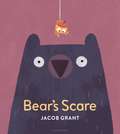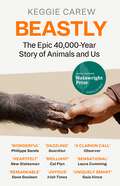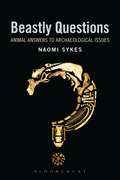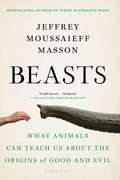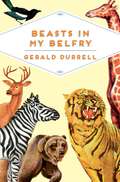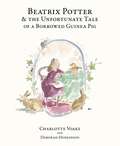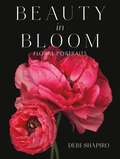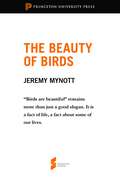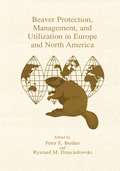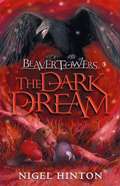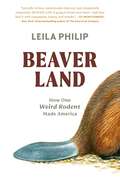- Table View
- List View
Bears of the North: A Year Inside Their Worlds
by Wayne LynchAn unprecedented visual and scientific journey into the secret world of bears.In Bears of the North, renowned wildlife photographer, naturalist, and bestselling author Wayne Lynch offers us a work of scintillating science and stunning beauty. Following polar bears, brown bears, and American and Asiatic black bears through the seasons, this journey is an insider's view of hibernation's mysteries and the birth of cubs in winter; the mating rituals and voracious appetites of spring; hunting, fishing, and encounters with neighbors during summer; and the feeding frenzy and exuberant play of autumn. Dispelling the stereotypes and untruths—but none of the magic—surrounding these magnificent animals, Lynch comments on the latest scientific discoveries related to the biology, behavior, and ecology of bears. He describes how satellite telemetry has revealed the purpose behind the meanderings of bears and the great distances they sometimes cover on land and in water. He also shows how DNA analysis can teach us about the relatedness of bears within a population, even revealing the identity of a particular cub's father. Taking us out into the wilds of the tundra and forests to share his firsthand observations of the marvelous bears of the Northern Hemisphere, Lynch describes their survival strategies and the threats they face from habitat fragmentation and global climate change. Lynch's fascinating narrative is enhanced by over 150 gorgeous, original color photographs that capture bears in their habitats, including appearances of the elusive moon bear, fierce polar bear battles, and rare images of mothers' intimate moments with their cubs. Informed by Lynch's nearly forty years of experience observing and photographing bears in the wild, and aided by sophisticated digital photo technologies, Bears of the North is an unrivaled collection of enthralling and informative portraits of bears in their natural environments.
Bear's Scare
by Jacob GrantBear likes to keep his house clean and tidy. In fact, the only thing Bear loves more than cleaning is taking care of his small stuffed friend, Ursa.Then Bear sees a sticky spiderweb . . . and where there's a web there is certainly a spider! The messy guest must be found, but what Bear and Ursa finally discover might just be an unlikely friend.Opposites attract in this adorable story, where new friends come in all shapes and sizes.
Bear's Scare
by Jacob GrantBear likes to keep his house clean and tidy. In fact, the only thing Bear loves more than cleaning is taking care of his small stuffed friend, Ursa.Then Bear sees a sticky spiderweb . . . and where there's a web there is certainly a spider! The messy guest must be found, but what Bear and Ursa finally discover might just be an unlikely friend.Opposites attract in this adorable story, where new friends come in all shapes and sizes.
The Beast Player
by Nahoko UehashiOne girl links beasts with humankind. She has the power to save them both. Or to destroy them.Erin's family have an important responsibility: caring for the fearsome serpents that form the core of their kingdom's army. So when some of the beasts mysteriously die, Erin's mother is sentenced to death as punishment. With her last breath she manages to send her daughter to safety.Alone, far from home, Erin soon discovers that she can talk to both the terrifying water serpents and the majestic flying beasts that guard her queen. This skill gives her great powers, but it also involves her in deadly plots that could cost her life. Can she save herself and prevent her beloved beasts from being used as tools of war? Or must she face the terrible battles to come?Nahoko Uehashi is a writer of fantasy titles, whose books have sold more than a million copies in her native Japan. She has won numerous awards, including the 2014 Hans Christian Andersen Award, which she received for her contribution to children's literature throughout her life. She has a Ph.D. in cultural anthropology and has studied indigenous peoples in Australia. She lives near Tokyo, Japan.
The Beast Warrior (The Beast Player)
by Nahoko UehashiThe thrilling conclusion to the sweeping fantasy adventure that began with The Beast PlayerTen years have passed since the events of The Beast Player. Elin and Ialu are married, with a young son, living a quiet, peaceful life when one day Elin is called upon to investigate a matter of great urgency: the fearsome Toda are dying and nobody knows why.As Elin investigates, she uncovers a deadly plot and a brewing invasion. Can she protect her homeland without allowing her beloved beasts to be used as weapons of war, or will she have to compromise her principles to save her family?
Beastly: A New History of Animals and Us
by Keggie CarewSHORTLISTED FOR THE WAINWRIGHT PRIZE FOR CONSERVATION A BOOK OF THE YEAR FOR THE FINANCIAL TIMES, WATERSTONES AND BBC HISTORY MAGAZINE A NEXT BIG IDEA CLUB MUST READ Beastly is the 40,000-year story of our changing kinship with the animal world - from the smallest microbe to the largest creature that ever lived. Exploring this relationship through history, culture, science and inspiring examples, Carew makes the passionate case that animals are the key to the planet's future health, but only if we can save them.
The Beastly Bunch
by Leisa Stewart-SharpeFlamingo Flo is throwing the most FABULOUS, most PERFECT pool party. And her spitty, smelly, bitey neighbours the Beastly Bunch are definitely NOT invited. But when Flo's true colours shine through, her guests leave and her perfect party is . . . a flop. Will Flo realise what friendship is REALLY all about before it's too late?The Beastly Bunch is a fun, riotous picture book that celebrates the importance of kindness and inclusivity - and reminds us that being fabulous is all about how you feel and how you treat others, NOT how you look!
Beastly encounters of the Raj: Livelihoods, livestock and veterinary health in North India, 1790–1920 (Studies in Imperialism)
by Saurabh MishraThis is the first full-length monograph to examine the history of colonial medicine in India from the perspective of veterinary health. The history of human health in the subcontinent has received a fair amount of attention in the last few decades, but nearly all existing texts have completely ignored the question of animal health. This book will not only fill this gap, but also provide fresh perspectives and insights that might challenge existing arguments. At the same time, this volume is a social history of cattle in India. Keeping the question of livestock at the centre, it explores a range of themes such as famines, agrarian relations, urbanisation, middle-class attitudes, caste formations etc. The overall aim is to integrate medical history with social history in a way that has not often been attempted.
Beastly Questions: Animal Answers to Archaeological Issues
by Naomi SykesZooarchaeology, or the study of ancient animals, is a frequently side-lined subject in archaeology. This is bizarre given that the archaeological record is composed largely of debris from human–animal relationships (be they in the form of animal bones, individual artifacts or entire landscapes) and that many disciplines, including anthropology, sociology, and geography, recognise human–animal interactions as a key source of information for understanding cultural ideology. By integrating knowledge from archaeological remains with evidence from texts, iconography, social anthropology and cultural geography, Beastly Questions: Animal Answers to Archaeological Issues seeks to encourage archaeological students, researchers and those working in the commercial sector to offer more engaging interpretations of the evidence at their disposal. Going beyond the simple confines of 'what people ate', this accessible but in-depth study covers a variety of high-profile topics in European archaeology and provides novel interpretations of mainstream archaeological questions. This includes cultural responses to wild animals, the domestication of animals and its implications on human daily practice, experience and ideology, the transportation of species and the value of incorporating animals into landscape research, the importance of the study of foodways for understanding past societies and how animal studies can help us to comprehend issues of human identity and ideology: past, present and future.
Beastly Questions: Animal Answers to Archaeological Issues
by Naomi SykesZooarchaeology, or the study of ancient animals, is a frequently side-lined subject in archaeology. This is bizarre given that the archaeological record is composed largely of debris from human–animal relationships (be they in the form of animal bones, individual artifacts or entire landscapes) and that many disciplines, including anthropology, sociology, and geography, recognise human–animal interactions as a key source of information for understanding cultural ideology. By integrating knowledge from archaeological remains with evidence from texts, iconography, social anthropology and cultural geography, Beastly Questions: Animal Answers to Archaeological Issues seeks to encourage archaeological students, researchers and those working in the commercial sector to offer more engaging interpretations of the evidence at their disposal. Going beyond the simple confines of 'what people ate', this accessible but in-depth study covers a variety of high-profile topics in European archaeology and provides novel interpretations of mainstream archaeological questions. This includes cultural responses to wild animals, the domestication of animals and its implications on human daily practice, experience and ideology, the transportation of species and the value of incorporating animals into landscape research, the importance of the study of foodways for understanding past societies and how animal studies can help us to comprehend issues of human identity and ideology: past, present and future.
Beasts: What Animals Can Teach Us About Human Nature
by Jeffrey Moussaieff MassonOrcas (or killer whales) are one of the planet's supreme predators. Alongside humans, they have the most complex brains to be found in nature. But while one of these two species has killed 200 million members of its own kind in the twentieth century alone, the other has killed none. This is where Jeffrey Masson's fascinating new book begins: there is something different about humans. Masson has shown us that animals can teach us much about our own emotions – about love (dogs), contentment (cats) and grief (elephants). But they have much to teach us about the negative emotions such as anger and aggression as well, and in unexpected ways. In Beasts he demonstrates that the violence we perceive in the 'wild' is mostly a matter of projection. We link the basest human behaviour to animals, to 'beasts', and claim the high ground for our species. We are least 'human', we think, when we succumb to our primitive, animal instincts. In fact, nothing could be further from the truth. Animal predators kill to survive, but there is nothing in the annals of animal aggression remotely equivalent to the violence mankind has inflicted upon itself. Humans, and humans in our modern industrialised world in particular, are the most violent species in existence. We lack what all other animals have: a check on aggression that serves the species rather than destroys it. And it is here that animals have something vitally important to teach us about ourselves.
Beasts: What Animals Can Teach Us About the Origins of Good and Evil
by Jeffrey Moussaieff MassonBestselling author Jeffrey Masson shows us what the animals at the top of the food chain-orca whales, big cats, etc.-can teach us about the origins of good and evil in ourselves.In his previous bestsellers, Masson has showed us that animals can teach us much about our own emotions-love (dogs), contentment (cats), and grief (elephants), among others. In Beasts, he demonstrates that the violence we perceive in the "wild†? is a matter of projection. Animals predators kill to survive, but animal aggression is not even remotely equivalent to the violence of mankind. Humans are the most violent animals to our own kind in existence. We lack what all other animals have: a check on the aggression that would destroy the species rather than serve it. In Beasts, Masson brings to life the richness of the animal world and strips away our misconceptions of the creatures we fear, offering a powerful and compelling look at our uniquely human propensity toward aggression.
Beasts Before Us: The Untold Story of Mammal Origins and Evolution
by Elsa PanciroliFor most of us, the story of mammal evolution starts after the asteroid impact that killed the dinosaurs, but over the last 20 years scientists have uncovered new fossils and used new technologies that have upended this story.In Beasts Before Us, palaeontologist Elsa Panciroli charts the emergence of the mammal lineage, Synapsida, beginning at their murky split from the reptiles in the Carboniferous period, over three-hundred million years ago. They made the world theirs long before the rise of dinosaurs. Travelling forward into the Permian and then Triassic periods, we learn how our ancient mammal ancestors evolved from large hairy beasts with accelerating metabolisms to exploit miniaturisation, which was key to unlocking the traits that define mammals as we now know them. Elsa criss-crosses the globe to explore the sites where discoveries are being made and meet the people who make them. In Scotland, she traverses the desert dunes of prehistoric Moray, where quarry workers unearthed the footprints of Permian creatures from before the time of dinosaurs. In South Africa, she introduces us to animals, once called 'mammal-like reptiles', that gave scientists the first hints that our furry kin evolved from a lineage of egg-laying burrowers. In China, new, complete fossilised skeletons reveal mammals that were gliders, shovel-pawed Jurassic moles, and flat-tailed swimmers.This book radically reframes the narrative of our mammalian ancestors and provides a counterpoint to the stereotypes of mighty dinosaur overlords and cowering little mammals. It turns out the earliest mammals weren't just precursors, they were pioneers.
Beasts in My Belfry (Pan Heritage Classics #10)
by Gerald DurrellWritten with Gerald Durrell's usual sharp eye for observing humour in any situation, Beasts in my Belfry will delight fans both old and new.At the age of two I made up my mind quite firmly and unequivocally that the only thing I wanted to do was study animals. Nothing else interested me.Beasts in My Belfry is a charming account of Gerald Durrell's first job in 1945 as a student keeper at Whipsnade Zoo. Over a year, we encounter a typically absurd cast - including Albert the lion, who's a dab hand at ventriloquism, and Teddy the brown bear, with whom the young Durrell sings duets. With notebook and pen in hand, the eager young Durrell observes his co-workers and animal charges alike. Whether getting dirty mucking out the buffalo enclosure or attempting to cajole a jitter-bugging gnu into a transportation crate, life at the zoo is certainly never boring.
Beasts Of Burden: Animal And Disability Liberation (pdf)
by Sunaura Taylor2018 American Book Award Winner A beautifully written, deeply provocative inquiry into the intersection of animal and disability liberation—and the debut of an important new social critic How much of what we understand of ourselves as “human” depends on our physical and mental abilities—how we move (or cannot move) in and interact with the world? And how much of our definition of “human” depends on its difference from “animal”? Drawing on her own experiences as a disabled person, a disability activist, and an animal advocate, author Sunaura Taylor persuades us to think deeply, and sometimes uncomfortably, about what divides the human from the animal, the disabled from the nondisabled—and what it might mean to break down those divisions, to claim the animal and the vulnerable in ourselves, in a process she calls “cripping animal ethics.” Beasts of Burden suggests that issues of disability and animal justice—which have heretofore primarily been presented in opposition—are in fact deeply entangled. Fusing philosophy, memoir, science, and the radical truths these disciplines can bring—whether about factory farming, disability oppression, or our assumptions of human superiority over animals—Taylor draws attention to new worlds of experience and empathy that can open up important avenues of solidarity across species and ability. Beasts of Burden is a wonderfully engaging and elegantly written work, both philosophical and personal, by a brilliant new voice.
Beatrix Potter and the Unfortunate Tale of the Guinea Pig
by Deborah Hopkinson Charlotte VoakeYoung Beatrix Potter loves to draw animals. She has many pets whom she likes to paint - a frog, a salamander, a canary and even a hedgehog. But she doesn't have a guinea pig so she borrows her neighbour's, promising that no harm will come to the cuddly creature. After all, what could possibly go wrong...?This hilarious and charming new book is based on Beatrix Potter's own diary entries, and is perfect for Potter fans young and old.
Beautiful Minds: The Parallel Lives of Great Apes and Dolphins
by Maddalena Bearzi Craig B StanfordApes and dolphins: primates and cetaceans. Could any creatures appear to be more different? Yet both are large-brained intelligent mammals with complex communication and social interaction. In the first book to study apes and dolphins side by side, Maddalena Bearzi and Craig B. Stanford, a dolphin biologist and a primatologist who have spent their careers studying these animals in the wild, combine their insights with compelling results. Beautiful Minds explains how and why apes and dolphins are so distantly related yet so cognitively alike and what this teaches us about another large-brained mammal: Homo sapiens. Noting that apes and dolphins have had no common ancestor in nearly 100 million years, Bearzi and Stanford describe the parallel evolution that gave rise to their intelligence. And they closely observe that intelligence in action, in the territorial grassland and rainforest communities of chimpanzees and other apes, and in groups of dolphins moving freely through open coastal waters. The authors detail their subjects’ ability to develop family bonds, form alliances, and care for their young. They offer an understanding of their culture, politics, social structure, personality, and capacity for emotion. The resulting dual portrait—with striking overlaps in behavior—is key to understanding the nature of “beautiful minds.”
Beauty in Bloom: Floral Portraits
by Debi ShapiroA poppy bud captured moments before blossoming. A statuesque tuberose as if carved out of alabaster. A pair of delicate pink dahlias joined like two starfish floating in the sea.Beauty in Bloom is the debut collection of work by Debi Shapiro, a visual artist who creates beautiful imagery inspired by her two passions—flowers and photography. More than 200 floral portraits in this exquisite book capture the depth and luminosity of a single bloom to lush bouquets with breathtaking intimacy and vibrant energy. Every translucent petal, tender green stem, and grain of pollen shimmers with painterly detail reminiscent of the works of the great botanical artists and engravers of the eighteenth century. From the bold crimson beauty of an Oriental poppy to the seductive lure of a pink Protea peeking out from behind its thick foliage to the timeless classic beauty of a garden rose, it&’s a flower lover&’s dream. Debi&’s work truly makes every bloom a leading lady.
The Beauty of Birds: Birds in Our Imagination and Experience"
by Jeremy MynottSpring returns and with it the birds. But it also brings throngs of birders who emerge, binoculars in hand, to catch a glimpse of a rare or previously unseen species or to simply lay eyes on a particularly fine specimen of a familiar type. In a delightful meditation that unexpectedly ranges from the Volga Delta to Central Park and from Charles Dickens's Hard Times to a 1940s London burlesque show, Jeremy Mynott ponders what makes birds so beautiful and alluring to so many people. Princeton Shorts are brief selections taken from influential Princeton University Press books and produced exclusively in ebook format. Providing unmatched insight into important contemporary issues or timeless passages from classic works of the past, Princeton Shorts enable you to be an instant expert in a world where information is everywhere but quality is at a premium.
The Beauty of Birds: Birds in Our Imagination and Experience"
by Jeremy MynottSpring returns and with it the birds. But it also brings throngs of birders who emerge, binoculars in hand, to catch a glimpse of a rare or previously unseen species or to simply lay eyes on a particularly fine specimen of a familiar type. In a delightful meditation that unexpectedly ranges from the Volga Delta to Central Park and from Charles Dickens's Hard Times to a 1940s London burlesque show, Jeremy Mynott ponders what makes birds so beautiful and alluring to so many people. Princeton Shorts are brief selections taken from influential Princeton University Press books and produced exclusively in ebook format. Providing unmatched insight into important contemporary issues or timeless passages from classic works of the past, Princeton Shorts enable you to be an instant expert in a world where information is everywhere but quality is at a premium.
The Beaver: Natural History of a Wetlands Engineer
by Dietland Müller-SchwarzeBeavers can and do dramatically change the landscape. The beaver is a keystone species—their skills as foresters and engineers create and maintain ponds and wetlands that increase biodiversity, purify water, and prevent large-scale flooding. Biologists have long studied their daily and seasonal routines, family structures, and dispersal patterns. As human development encroaches into formerly wild areas, property owners and government authorities need new, nonlethal strategies for dealing with so-called nuisance beavers. At the same time, the complex behavior of beavers intrigues visitors at parks and other wildlife viewing sites because it is relatively easy to observe.In an up-to-date, exhaustively illustrated, and comprehensive book on beaver biology and management, Dietland Müller-Schwarze gathers a wealth of scientific knowledge about both the North American and Eurasian beaver species. The Beaver is designed to satisfy the curiosity and answer the questions of anyone with an interest in these animals, from students who enjoy watching beaver ponds at nature centers to homeowners who hope to protect their landscaping. Photographs taken by the authors document every aspect of beaver behavior and biology, the variety of their constructions, and the habitats that depend on their presence. Beaver facts:•Just as individual beavers shape their immediate surroundings, so did the distribution of beavers across North America influence the paths of English and French explorers and traders. As a result of the fur trade, beavers were wiped out across large areas of the United States. Reintroduction efforts led to the widespread establishment of these resilient animals, and now they are found throughout North America, Europe, and parts of the southern hemisphere.•Beaver meadows provided early settlers with level, fertile pastures and hayfields.•Based on the fossil record, the smallest extinct beaver species were the size of a muskrat, and the largest may have reached the size of a black bear (five to six times as large as today's North American beavers). Beaver-gnawed wood has been found alongside the skeleton of a mastodon.•Some beavers remain in the home lodge for an extra year to assist their parents in raising younger siblings. They feed, groom, and guard the newborn kits.•In 1600, beaver ponds covered eleven percent of the upper Mississippi and Missouri Rivers' watershed above Thebes, Illinois. Restoring only 3 percent of the original wetlands might suffice to prevent catastrophic floods such as those in the early 1990s.
Beaver Protection, Management, and Utilization in Europe and North America
by Peter E. Busher Ryszard M. DzieciolowskiBy the end of the 19th century both beaver species had been extirpated from large portions of their native ranges. The global decline in beaver populations was the direct re sult of exploitation by humans. Now, at the end of the 20th century, protection, manage ment, and reintroduction programs, coupled with a decline in the demand for beaver fur and other products, have allowed beaver populations to increase dramatically. Since bea vers actively modify their local environment their activities can conflict with human land use. Because of this, the beaver, once considered a unique and exotic component of wet lands, is now often considered a nuisance species. The history, as well as the current status, of beaver populations in Europe and North America provide insight into how con servation programs work, and into how humans and wildlife interact. The initial plenary lecture of the Euro-American Mammal Congress (July, 1998) was presented by Dr. Michael L. Rosenzweig, a professor at the University of Arizona. Dr. Rosenzweig discussed how humans have used and continue to use natural resources, in cluding wildlife and wildland. He provided evidence indicating that the current model of reservation conservation could not provide a long-term solution to the human-wild life/wildland conflict. Dr. Rosenzweig emphasized that what is required is a move away from purely exploitive activities (I would call this exploitive ecology) and the develop ment of a reconciliation ecology with wildlife.
Beaver Towers: The Dark Dream (Beaver Towers Ser.)
by Nigel HintonIn this fourth BEAVER TOWERS adventure, Philip and old Mr Edgar set off on their travels so that Philip can learn how to use his powers to fight evil. But while they are away, the island itself is under threat from a strange creature named Retson. This time it is up to Baby B, the little beaver and Nick, the hedgehog, to save the day.
Beaverland: How One Weird Rodent Made America
by Leila PhilipAn intimate and revelatory dive into the world of the beaver—the wonderfully weird rodent that has surprisingly shaped American history and may save its ecological future. From award-winning writer Leila Philip, Beaverland is a masterful work of narrative science writing, a book that highlights, though history and contemporary storytelling, how this weird rodent plays an oversized role in American history and its future. She follows fur trappers who lead her through waist high water, fur traders and fur auctioneers, as well as wildlife managers, PETA activists, Native American environmental vigilantes, scientists, engineers, and the colorful group of activists known as beaver believers. Beginning with the early trans-Atlantic trade in North America, Leila Philip traces the beaver&’s profound influence on our nation&’s early economy and feverish western expansion, its first corporations and multi-millionaires. In her pursuit of this weird and wonderful animal, she introduces us to people whose lives are devoted to the beaver, including a Harvard scientist from the Blackfeet Reservation in Montana, who uses drones to create 3-dimensional images of beaver dams; and an environmental restoration consultant in the Chesapeake whose nickname is the &“beaver whisperer&”. What emerges is a poignant personal narrative, a startling portrait of the secretive world of the contemporary fur trade, and an engrossing ecological and historical investigation of these heroic animals who, once trapped to the point of extinction, have returned to the landscape as one of the greatest conservation stories of the 20th century. Beautifully written and impeccably researched, Beaverland reveals the profound ways in which one odd creature and the trade surrounding it has shaped history, culture, and our environment. The New York Times Editors' Choice NPR Science Friday Book Club Selection
Beavers: Boreal Ecosystem Engineers
by Carol A. JohnstonBridging the fields of ecosystem science and landscape ecology, this book integrates Dr. Carol Johnston's research on beaver ecosystem alteration at Voyageurs National Park. The findings about the vegetation, soils, and chemistry of beaver impoundments synthesized in the text provide a cohesive reference useful to wetland scientists, ecosystems and landscape ecologysts, wildlife managers, and students. The beaver, Castor canadensis, is an ecosystem engineer unequaled in its capacity to alter landscapes through browsing and dam building, whose population recovery has re-established environmental conditions that probably existed for millenia prior to its near extirpation by trapping in the 1800s and 1900s. Beavers continue to regain much of their natural range throughout North America, changing stream and forest ecosystems in ways that may be lauded or vilified. Interest in beavers by ecologists remains keen as new evidence emerges about the ecological, hydrological, and biogeochemical effects of beaver browsing and construction. There is a critical need for ecologists and land managers to understand the potential magnitude, persistence, and ecosystem services of beaver landscape transformation. The 88-year record of beaver landscape occupation and alteration documented by Dr. Carol Johnston and colleagues from aerial photography and field work provides a unique resource toward understanding the ecosystem effects and sustainability of beaver activity.

